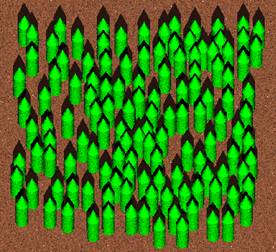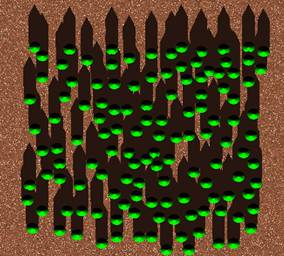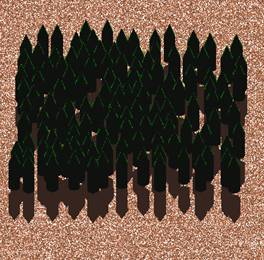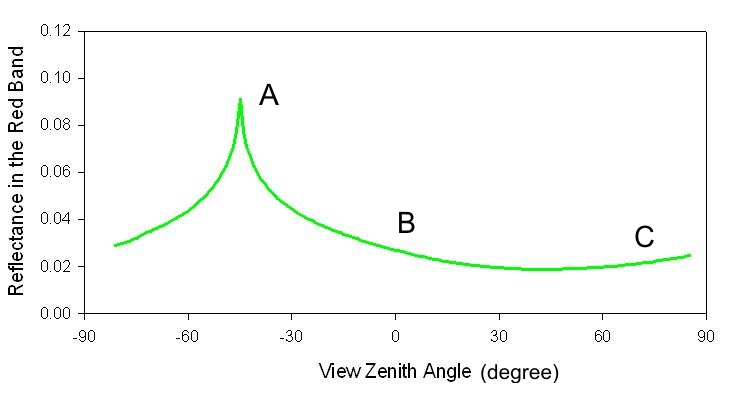The Five-Scale radiative transfer model
S.G. Leblanc, Canada Centre for Remote Sensing, Natural Resources Canada.
Introduction
A radiative transfer model simulates radiation transfer processes in certain media, such as vegetation and atmosphere. For vegetation, it computes the interaction between solar radiation and plants. Solar radiation reflected from the Earth’s surfaces and measured by satellites depends strongly on the angles of the sun and the satellite in relation to the surface. This bi-directional behaviour is quantified using the Bi-directional Reflectance Distribution Function (BRDF). Five-Scale is thus used to simulate what optical remote sensing instruments are measuring when observing vegetation canopies. “Five-Scale” is a radiative transfer model that simulates the BRDF according to structural and biochemical properties of the vegetation.
 |
 |
 |
| Image A | Image B | Image C |
Figure 1: BRDF rendering of a forest canopy composed of opaque cone and cylindrical objects viewed from 3 angles:
- backward scattering, where the sun and the viewer are on the same side, hiding most of the shadows;
- nadir view, where a maximum of the background can be seen; and
- forward scattering where the sun and the viewer are on the opposite side.
Text version
Figure 1
The figure shows three situations between tree cover and the position of the sun and the sensor. Image "A" shows a group of trees where you can see the trees, not the shadow, because the sun and the aim of the sensor are in the same direction. Image "B" shows the same group of trees observed at nadir and where trees and their shadows are visible. Image "C" shows the group of trees where we only see the trees as the tops and trunks are hidden by the shade of nearby trees. This phenomenon occurs when the sun and the sensor are in opposite directions.
Why our model is named “Five-Scale”?
In Five-Scale, the solar radiation interaction with the foliage is considered at five different scales: within groups of trees, within individual crowns, within branches, within shoots, and within needles (leaves for deciduous).

Figure 2: "Five-Scale" simulated reflectance from a forest canopy at different view zenith angles on the plane parallel to the sun.
Text version
Figure 2
The figure shows a graph where the horizontal axis corresponds to the viewing angle from nadir. The vertical axis shows the reflectance in the red band of the spectrum. The curve shows that there is a peak reflectance at angles corresponding to the image "A", and lower reflectance at angles corresponding to the images "B" and "C".
Applications
Five-Scale has been used to develop a vegetation index (namely the reduced simple ratio) that is less sensitive to different background than previously used indices and to assess the level of foliage clumping within a pixel using angular properties of the vegetation in the pixel.
Further information
Five-Scale’s code and a Microsoft Windows version are available on request from Sylvain G. Leblanc.
References
Leblanc, S. G., Chen, J. M., White, H. P. Latifovic, R., Lacaze, R., and Roujean, J.-L. Canada-wide foliage clumping index mapping from multi-angular POLDER measurements. Can. J. Remote Sensing. Vol. 31, No. 5, pp 364-376. 2005.
Leblanc, S. G. and Chen, J. M., A Windows Graphic User Interface (GUI) for the Five-Scale model for fast BRDF simulations. Rem. Sens. Reviews, Vol. 19, pp. 293-305, 2000.
Chen, J. M., and Leblanc, S. G., Multiple-scattering scheme useful for geometric optical modelling. IEEE TGARS, Vol. 39, pp. 1061-1071, 2001.
Brown, L. J., Chen, J. M., Leblanc, S. G., and Cihlar, J. A Shortwave Infrared Modification to the Simple Ratio for LAI Retrieval in Boreal Forests: An Image and Model analysis. Rem. Sens. Environ. Vol. 71 (1), pp.16-25, 2000.
Leblanc, S. G., Bicheron, P., Chen, J. M., Leroy, M., and Cihlar, J. Investigation of directional reflectance in boreal forests using an improved 4-Scale model and airborne POLDER data. IEEE TGARS, Vol. 37, No. 3, pp. 1396-1414, 1999.
Chen, J.M. and Leblanc, S. G., A four-scale bidirectional reflectance model based on canopy architecture, IEEE TGARS, Vol. 35, pp. 1316-1337, 1997.
Page details
- Date modified: